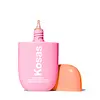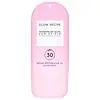What's inside
What's inside
 Key Ingredients
Key Ingredients

 Benefits
Benefits

 Concerns
Concerns

 Ingredients Side-by-side
Ingredients Side-by-side

Zinc Oxide 21.7%
Cosmetic ColorantWater
Skin ConditioningC13-15 Alkane
SolventCaprylic/Capric Triglyceride
MaskingButyloctyl Salicylate
Skin ConditioningPropanediol
SolventMica
Cosmetic ColorantPolyglyceryl-2 Dipolyhydroxystearate
Skin ConditioningPolyglyceryl-3 Diisostearate
EmulsifyingSilica
AbrasiveC12-15 Alkyl Benzoate
AntimicrobialPolyglyceryl-3 Polyricinoleate
EmulsifyingGalactoarabinan
Allantoin
Skin ConditioningFructooligosaccharides
HumectantBioflavonoids
Skin ConditioningGlycoproteins
Skin ConditioningBisabolol
MaskingCeramide Ng
Skin ConditioningLactic Acid
BufferingSodium Hyaluronate
HumectantPalmitoyl Hexapeptide-12
Skin ConditioningCyamopsis Tetragonoloba Gum
Emulsion StabilisingTocopheryl Acetate
AntioxidantDisteardimonium Hectorite
StabilisingGlycerin
HumectantPolyhydroxystearic Acid
EmulsifyingTribehenin
EmollientIsostearic Acid
CleansingLecithin
EmollientXanthan Gum
EmulsifyingSodium Chloride
MaskingPhytic Acid
Pentylene Glycol
Skin ConditioningPhenethyl Alcohol
MaskingCI 77891
Cosmetic ColorantCI 77491
Cosmetic ColorantCI 77492
Cosmetic ColorantZinc Oxide 21.7%, Water, C13-15 Alkane, Caprylic/Capric Triglyceride, Butyloctyl Salicylate, Propanediol, Mica, Polyglyceryl-2 Dipolyhydroxystearate, Polyglyceryl-3 Diisostearate, Silica, C12-15 Alkyl Benzoate, Polyglyceryl-3 Polyricinoleate, Galactoarabinan, Allantoin, Fructooligosaccharides, Bioflavonoids, Glycoproteins, Bisabolol, Ceramide Ng, Lactic Acid, Sodium Hyaluronate, Palmitoyl Hexapeptide-12, Cyamopsis Tetragonoloba Gum, Tocopheryl Acetate, Disteardimonium Hectorite, Glycerin, Polyhydroxystearic Acid, Tribehenin, Isostearic Acid, Lecithin, Xanthan Gum, Sodium Chloride, Phytic Acid, Pentylene Glycol, Phenethyl Alcohol, CI 77891, CI 77491, CI 77492
Butyl Methoxydibenzoylmethane 3%
UV AbsorberHomosalate 7%
Skin ConditioningEthylhexyl Salicylate 5%
UV AbsorberWater
Skin ConditioningButyloctyl Salicylate
Skin ConditioningDiisopropyl Adipate
EmollientOleyl Erucate
EmollientNiacinamide
SmoothingGlycerin
HumectantCetearyl Alcohol
EmollientDiheptyl Succinate
EmollientAmmonium Polyacryloyldimethyl Taurate
Emulsion StabilisingPhenoxyethanol
PreservativeCoco-Glucoside
CleansingCapryloyl Glycerin/Sebacic Acid Copolymer
Skin ConditioningGlycine Soja Oil
EmollientXylitylglucoside
HumectantHydroxyacetophenone
AntioxidantTocopherol
AntioxidantAnhydroxylitol
HumectantParfum
MaskingCitrullus Lanatus Seed Oil
EmollientPongamia Pinnata Seed Extract
Skin ConditioningPolyglyceryl-3 Diisostearate
EmulsifyingXylitol
HumectantEthylhexylglycerin
Skin ConditioningHyaluronic Acid
HumectantOryza Sativa Extract
AbsorbentOryza Sativa Germ Extract
EmollientSodium Phytate
Glucose
HumectantHydrogenated Palm Glycerides Citrate
EmollientButyl Methoxydibenzoylmethane 3%, Homosalate 7%, Ethylhexyl Salicylate 5%, Water, Butyloctyl Salicylate, Diisopropyl Adipate, Oleyl Erucate, Niacinamide, Glycerin, Cetearyl Alcohol, Diheptyl Succinate, Ammonium Polyacryloyldimethyl Taurate, Phenoxyethanol, Coco-Glucoside, Capryloyl Glycerin/Sebacic Acid Copolymer, Glycine Soja Oil, Xylitylglucoside, Hydroxyacetophenone, Tocopherol, Anhydroxylitol, Parfum, Citrullus Lanatus Seed Oil, Pongamia Pinnata Seed Extract, Polyglyceryl-3 Diisostearate, Xylitol, Ethylhexylglycerin, Hyaluronic Acid, Oryza Sativa Extract, Oryza Sativa Germ Extract, Sodium Phytate, Glucose, Hydrogenated Palm Glycerides Citrate
 Reviews
Reviews

Ingredients Explained
These ingredients are found in both products.
Ingredients higher up in an ingredient list are typically present in a larger amount.
Butyloctyl Salicylate is a chemical UV filter structurally similar to octisalate. It is a photostabilizer, SPF booster, emollient and solvent. This ingredient helps evenly spread out ingredients.
According to a manufacturer, it is suitable for pairing with micro Titanium Dioxide, Zinc Oxide, and pigments.
Photostabilizers help stabilize UV-filters and prevents them from degrading quickly.
Learn more about Butyloctyl SalicylateGlycerin is already naturally found in your skin. It helps moisturize and protect your skin.
A study from 2016 found glycerin to be more effective as a humectant than AHAs and hyaluronic acid.
As a humectant, it helps the skin stay hydrated by pulling moisture to your skin. The low molecular weight of glycerin allows it to pull moisture into the deeper layers of your skin.
Hydrated skin improves your skin barrier; Your skin barrier helps protect against irritants and bacteria.
Glycerin has also been found to have antimicrobial and antiviral properties. Due to these properties, glycerin is often used in wound and burn treatments.
In cosmetics, glycerin is usually derived from plants such as soybean or palm. However, it can also be sourced from animals, such as tallow or animal fat.
This ingredient is organic, colorless, odorless, and non-toxic.
Glycerin is the name for this ingredient in American English. British English uses Glycerol/Glycerine.
Learn more about GlycerinPolyglyceryl-3 Diisostearate is an emulsifer and emollient. It comes from Isostearic Acid and Polyglycerin-3.
As an emulsifier, it helps stabilize products by preventing oils and water from separating.
This ingredient may not be Malassezia folliculitis, or fungal acne safe.
Learn more about Polyglyceryl-3 DiisostearateWater. It's the most common cosmetic ingredient of all. You'll usually see it at the top of ingredient lists, meaning that it makes up the largest part of the product.
So why is it so popular? Water most often acts as a solvent - this means that it helps dissolve other ingredients into the formulation.
You'll also recognize water as that liquid we all need to stay alive. If you see this, drink a glass of water. Stay hydrated!
Learn more about Water